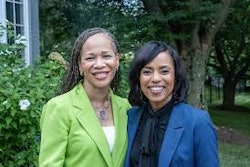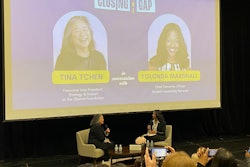At Georgetown University, Dr. Michael Eric Dyson, a sociology professor, author and broadcast commentator, teaches a course about Jay Z. He examines the rap icon’s vast body of work from a sociological and historical standpoint. Dyson helps his students try to understand the poetry embedded in the superstar performer’s work. He provides an academic perspective to help his students understand Jay Z’s thoughts about being Black in a White world.
Several other faculty members at Georgetown teach classes that explore the world of hip-hop using the visual arts, literature, dance, music and theater.
At San Francisco State University, Dr. Dawn-Elissa Fischer, an associate professor of Africana studies, co-teaches a hip-hop course from a social justice perspective. She says the course, which attracts more than 100 students and often has a waiting list, is one of the oldest hip-hop courses in the country.
Sometimes the instructors bring in artists as guest speakers. Sometimes they dance or create art. Other times they study lyrics and conduct a lyrical analysis of annotated bibliographies that cover peer-reviewed research and cultural criticism.
Fischer has also recently received a Nasir Jones Fellowship at the Hutchins Center for African & African American Research at Harvard University for fall 2016. This fellowship is part of the Hiphop Archive and Research Institute (HARI), which is founded and directed by Dr. Marcyliena Morgan.
Growth and misconceptions
A few years ago, the University of Arizona took hip-hop in academia a step further by introducing a concentration in hip-hop as part of the Africana studies minor, a move that received considerable national attention (and some derision from critics who took to social media to question its place in the academy).
Comedian Conan O’Brien quipped: “That’s the one class you don’t want to cheat off an Asian kid.” Daniel Asia, a professor of music at the University of Arizona, told Tuscon.com that the hip-hop minor was “a trendy addition to the curriculum” that would ultimately cheapen the university’s reputation.
In mid-March, Bowie State University, a historically Black university in suburban Washington, D.C., announced the introduction of a minor in hip-hop studies. The program curriculum is a mix of technology, the arts, media and history. The university plans to offer courses that examine hip-hop’s roots in African culture, its societal impact as well as visual design.
Hip-hop is thriving in the academy as an interdisciplinary program that blends music, film, literature, history, sexuality, gender identity, commerce and art. No one seems to know exactly how many universities offer courses or minors in the subject but the numbers are bountiful and appear to be rising.
“There is growing coursework and there are growing numbers,” says Dr. Christopher Emdin, an associate professor in the Department of Mathematics, Science and Technology at Teachers College, Columbia University and author of the book Urban Science Education for the Hip-Hop Generation. “There are courses at Georgetown, Rice, Princeton, Harvard, Duke, Tufts, UNC, Toronto, Columbia. It is truly taking root in academia.”
Despite the rise in hip-hop courses in the academy, scholars who tackle the subject must often battle misconceptions.
“Basically, both the general and academic public often think of hip-hop as music-oriented only,” Dr. Alain-Philippe Durand, director of the School of International Languages/Literatures and Cultures at the University of Arizona, said in an email. “That translates, for some individuals, into the short-sighted belief that hip-hop is rap music (emceeing and deejaying) only. Therefore, to this day, when people hear about our minor in hip-hop, at first, many of them wrongly assume that the program teaches one how to become a rapper or a DJ and that it is hosted in the Music Department.
“Moreover, because of the same wrong assumption, ignorance and a certain casual elitism that scholars specializing in Africana and African-American studies are well familiar with, hip-hop studies are regularly mocked and not taken seriously as a research discipline.”
Emdin says the academy would be remiss in dismissing the value of hip-hop as a subject worthy of scholarship.
“We create fields of study because they are so complex, not because they are easy,” he says, adding that hip-hop is a multifaceted cultural and social force. He compares it to jazz, which he calls “a uniquely American phenomenon.”
“Many people say jazz was hip-hop’s ancestor because of the use of improvisation. There are all these tributaries, points of exploration. You could start talking about linguistics, how language is used, geography, social issues and how hip-hop artists reflect the cultural milieu of their time. How could you not explore this as minor and major? It’s not about the answers but the questions not answered.”
Adds Durand: “Hip-hop has become an all-pervasive key component of contemporary American society, culture and identity, which warrants serious academic inquiry.”
He says the minor offered at the University Arizona serves a dual purpose: “This minor not only embraces the students’ own cultural contexts and experiences, but also prepares and equips them to function and understand the 21st century cultural realities that will confront them after graduation.
“Hip-hop has not only become a comprehensive, ubiquitous cultural expression, but it has also turned out to be a phenomenal cultural force that has influenced and shaped local, regional, national and worldwide issues in its 30-plus years of existence.”
Engaging the imagination
Emdin says that it is important to understand the distinction between teaching about hip-hop and the use of hip-hop as a teaching tool to reach students. Emdin is the co-creator of #HiphopEd, a social media movement that includes other academics as well as middle school and high school teachers, college students, and graduate students studying hip-hop.
“These are folks interested in [the] process of teaching and learning and engaging the imagination,” he says.
This concept of engaging the imagination is what intrigued Dr. Joycelyn Wilson, an assistant professor of educational foundations at Virginia Tech, about the idea of using hip-hop as a teaching tool.
Twenty years ago, as a newly minted high school algebra teacher, she began using hip-hop to reach students.
“The school was very diverse and I was able to see this common denominator — the engagement in hip-hop. I started playing instrumental music in class while they were doing their work. It was a conversation piece,” says Wilson, who integrates hip-hop and hip-hop pedagogies into her graduate courses.
“Those conversations we would have in class led to stronger relationships. They trusted me a little more and hip-hop was the bridge to do it. Hip-hop was that thing [that] gave me authority in the classroom and also gave me my access to the students. That’s when I knew this is worth studying.”
She recalls being reached in the same way as a middle school student.
“I remember when the Fat Boys [rap group] came to my middle school with the message of staying in school,” says Wilson. “Hip-hop is a learning environment. It always comes with instructions and always comes with a message.”
Dr. Soyica Colbert, an associate professor of African-American studies and theater and performance studies at Georgetown, says hip-hop gives teachers and college professors the advantage of meeting students “where they are.”
“There’s always some interest point,” she says, adding that it gives instructors different entry points into the course materials. “The other thing is that hip-hop is often collaborative. That is central to the best kind of teaching. It allows students to think about collaboration.”
Adds Wilson: “I’ve been able to see the way it enhances learning. You’re meeting the kids or using a Black cultural art form. You are teaching them using their indigenous ways that they respond to because of who they are ethnically and culturally.” She adds that students can be engaged “using texts, artifacts, poetry” and “other tangible things that a student responds [to] when they’re learning.”
“You’re using art. I think a lot of times we get confused about why hip-hop is so popular. TV didn’t make hip-hop popular. It got on TV because it is so popular. Hip-hop [is] so well-received when you’re using it as a pedagogical intervention. That’s why it’s so well-received by White suburban kids.”
That mass appeal coupled with its soaring influence in high places makes it a subject worth exploring in the ivy towers, says Emdin.
“Obama is the hip-hop generation’s first president,” he says, adding that the first family has helped take the hip-hop culture mainstream. “He gave Michelle Obama a fist bump at a rally during the 2008 campaign. Look at Michelle Obama[’s] ‘Let’s Move’ campaign. Sasha or Malia wearing [a] t-shirt that had Joey Bada$$ on it. The Obamas are signaling that hip-hop is crossing into the political realm. Folks in higher places understand the depths of it. That’s why we’ve got to study this thing.”















